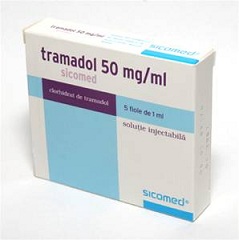If you have been taking tramadol for a long period of time under the care of a doctor and have become dependent on the drug, or have been abusing tramadol in one way or another, it is important that you attend tramadol withdrawal treatment in a safe, medically-equipped rehab center. Tramadol withdrawal, like other types of opioid withdrawal syndromes, can be painful and uncomfortable, but it can also be incredibly dangerous in ways opioid withdrawal usually is not. Therefore, you should attend professional treatment for your symptoms and know what to expect from tramadol withdrawal.
The Basics of Tramadol Withdrawal

Tramadol withdrawal can cause panic and nervousness.
According to the National Library of Medicine, you should never stop taking tramadol suddenly or to try and stop “cold turkey,” a term that is used to describe the goose bumps people experience when they go through opioid withdrawal. “If you suddenly stop taking tramadol, you may experience [other] withdrawal symptoms” associated with opioid withdrawal and dependence, such as:
- Panic
- Nervousness
- Sweating
- Difficulty falling asleep or staying asleep
- Runny nose
- Sneezing
- Coughing
- Muscle and bone pain
- Chills
- Nausea
- Uncontrollable shaking of a part of your body
- Diarrhea
These are the general withdrawal symptoms that most individuals can expect to experience if they suddenly stop taking or abusing tramadol. However, stopping use of the drug can also cause psychosis in certain rare cases, including hallucinations, paranoia, anxiety, panic attacks, confusion, numbness of extremities, and delusions. According to a case study from Addict Health, “Psychosis is one of tramadol[‘s] atypical withdrawal symptoms which” for one patient “subsided a few days after suppression of withdrawal symptoms.”
Mostly, psychosis affects those individuals who have been abusing tramadol prior to quitting their abuse of the drug, but there is no way to know for certain which patient may be affected by this issue. Because of the uncertainty involved in the severity of tramadol withdrawal, it is best that individuals attempting to quit their use of the drug for any reason attend professional treatment.
Initial Tests and Program Planning
When you first arrive at a tramadol withdrawal treatment facility, you will likely be asked a number of questions about your drug use and whether or not you are currently on or abusing any other medications or illegal drugs. Then, “urine or blood tests to screen for drugs” will often be performed (NLM). Afterward, you can often discuss your treatment program with your doctor, including what you will need in regards to your treatment, whether or not you will require aftercare or addiction treatment after your withdrawal symptoms have subsided, and what medications you will require during your medically-assisted withdrawal.
Withdrawal Treatment and Safety Precautions
You will then begin your withdrawal treatment, whether by being stabilized on a certain medication or by being slowly weaned off tramadol. You can receive help from your personal physician when minimizing your tramadol use through treatment, but because of the potential for psychotic symptoms developing, you may want to choose to attend treatment at an inpatient facility. There, you will receive 24-hour care where you will also be in a controlled environment that provides medical treatment when necessary. However, if you do not believe this is the right treatment for you, you may receive your medication from a doctor’s office or from an outpatient clinic, depending on the medication you choose.
Opioid withdrawal is often treated with one of three types of medications:
- Clonidine: an antihypertensive agent
- Methadone: an opioid agonist
- Buprenorphine: a partial opioid agonist
Methadone and buprenorphine are the best medications to receive in the case of tramadol withdrawal treatment, as they block the opioid receptors in the brain and should be able to minimize most of your withdrawal symptoms, including cravings for the drug. In withdrawal treatment, you may often be encouraged to attend therapy sessions as well to help you decide where your recovery may need to lead you next and to work through any issues that helped cause or were caused by your tramadol abuse.
With treatment, tramadol withdrawal can last anywhere from a week to two weeks or longer, depending on how long you and your doctor decide that you will stay on medication and how long it will take to slowly wean you off it.
In Case of an Emergency…
According to the US Department of Justice, the dangerous and frightening symptoms of psychosis that sometimes occur during this condition are only “encountered in about 10 percent of cases of tramadol withdrawal.” However, this serious issue can occur, and you and your doctor should be prepared for the possibility.
If you do happen to experience psychotic symptoms during your tramadol withdrawal treatment, it is likely that you will be treated with medications, such as hypnotic drugs and sedatives. You may also receive analgesic medications as well. It is unlikely that you will be given antipsychotic medications unless the situation is extremely dire.
In the instance that you are receiving treatment for tramadol withdrawal from somewhere other than an inpatient facility and you suddenly begin to experience psychotic symptoms, it is much safer for you to be moved to an inpatient facility where you can be monitored and prevented from endangering yourself or others. According to the study on the patient who presented psychotic symptoms as a result of tramadol withdrawal, “After three days, all physical and mental symptoms including hallucinations and delusions completely subsided.”
After Withdrawal Treatment
You may require additional treatment after your withdrawal symptoms have subsided and you are no longer dependent on tramadol. If you have been abusing the drug, it is highly necessary that you attend addiction treatment as well, as medically-assisted withdrawal is not a treatment for addiction but rather for the symptoms caused by withdrawal. If you are unsure as to whether or not you need addiction treatment, discuss the matter with your doctor and find out if additional help from a rehab center, mutual-help group, drug counselor, or another type of addiction treatment is necessary.
Do You Want to Learn More About Tramadol Withdrawal Treatment?
The process of tramadol withdrawal can be a difficult time, but you will be much safer and less anxious when you understand what your treatment will entail. Call 800-442-6158 Who Answers? today for advice and help with finding the right treatment for your withdrawal.









